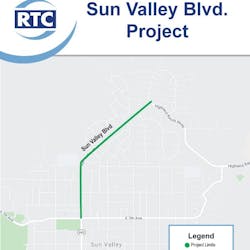RTC Washoe County to begin construction to improve Sun Valley Boulevard
The Regional Transportation Commission (RTC) of Washoe County is scheduled to begin construction June 22 to improve Sun Valley Boulevard from 7th Avenue to Highland Ranch Parkway.
The project will increase safety in the neighborhood and benefit drivers, pedestrians, bicyclists and transit users.
Two-way traffic will be maintained within the construction zone for the time being, but drivers can anticipate lane closures and potential intersection closures as the project progresses. During paving operations, one-way northbound traffic will be in place on Sun Valley Boulevard. Washoe County RTC will provide advance notice of one-way traffic operations.
The agency does anticipate increased traffic within the construction zone and encourages drivers coming from Sparks to use Pyramid Highway instead of cutting through to Sun Valley Boulevard, when possible. Homes and businesses along this corridor will remain accessible during construction.
Phase one of the project includes improvements on Sun Valley Boulevard from 7th Avenue to Highland Ranch Parkway, including:
- Two new pedestrian-activated rapid flashing beacon crossings at Quartz Lane and Middle Fork Drive.
- Dedicated left-turn lane from northbound Sun Valley Boulevard to Staci Way.
- Americans with Disabilities Act (ADA) improvements.
- New sidewalks and bike lanes.
- Drainage improvements.
- New pavement.
- An upgraded traffic signal at Sun Valley Boulevard/7th Street and a reconfiguration of the intersection to improve safety.
- Aesthetic improvements.
The project is anticipated to be substantially complete in December 2020, weather permitting, according to the agency.
Washoe County RTC’s contracted construction crews will follow the Nevada Occupational Health and Safety Administration’s construction-safety guidance.
The Sun Valley Boulevard Project was developed following the Sun Valley Boulevard Corridor Study in 2015, which focused on the area from Clear Acre Lane to Highland Ranch Parkway. Phase one of this project represents an approximate $8-million investment in the community funded with local fuel-tax revenue.


